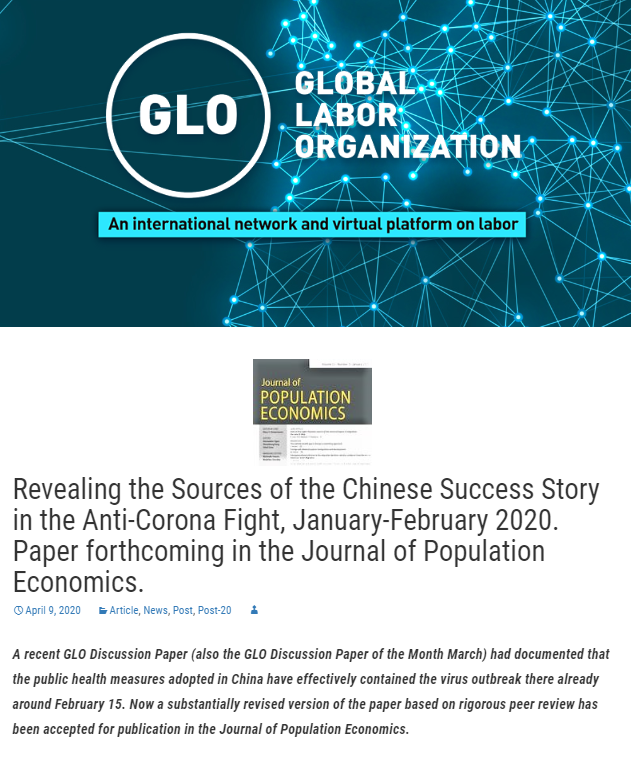A recent GLO discussion paper Impacts of Social and Economic Factors on the Transmission of Coronavirus Disease 2019 (COVID-19) in China by IESR faculty members Yun Qiu and Wei Shi, co-authored with <a style="color:#4f81bd;text-decoration:underline; target="_self" sudyfile-attr="{'title':'只支持选中一个链接时生效'}">Xi Chen from Yale University, was accepted for publication in the Journal of Population Economics.
The study analyzes various public health measures imposed by Chinese government in late January 2020 that significantly decreased COVID-19 transmission rate and eventually contained the virus spread by the mid-February.
As Klaus F. Zimmermann, GLO President and Editor-in-Chief of the Journal notes, this is the first published paper in an economics journal that deals with the coronavirus challenge – it provides extensive knowledge on how it happened and what the reactions of public authorities and Chinese people were in the time of the outbreak. The primary objective of this rigorous study, he adds, is to separate the epidemiological process from those responses and to quantify them in the face of a difficult data situation. In this way, the paper defines methodological standards and provides conclusions that will serve as a reference for many future studies in China and all parts of the world.
As to what made this study a good fit with the Journal of Population Economics, Zimmermann believes that this research deals with a question that is at the core of population economics, since the virus crucially affects human risky behavior, wellbeing and mortality. The study also distinguishes itself from other related work appeared on scientific and medical journals by giving a specific economic focus to the analysis of individual and government behavior and counterfactual investigations, he indicates.
Although the authors and the Journal have seen the perfect match for this article early on, Zimmermann notes, the paper still had to go through the standard, high-quality anonymous peer refereeing. Three referees provided detailed reports with substantial requests for revision within a week, while a normal response time would be about six weeks, he recalls. Then, within the following two weeks, the authors convincingly and in great detail responded to all of the peer reviewers’ suggestions thus allowing to reach the best possible outcome at this time. Zimmermann says that all parties were very supportive due to the particular importance of this research for the current global debate, therefore the Journal kept all administrative procedures at the minimum.
Speaking of China’s fight against the COVID-19 and the measures it has taken, Zimmermann believes that social distancing and the tracing of networks of infections are crucial for containing the disease, as all previous pandemics showed. The lockdown strategy has proved to be very effective in China which, although with some delay at times, was adopted in many other countries. However, he points out, since the challenge without proper medicine and with missing herd immunity is long-term, one should be cautious in pretending that the best detailed strategy is already obvious. He also observes that the fear about a second wave of infections is already present world-wide, therefore we need to learn from all those differentiated strategies across the countries in handling the crisis and to search and test for hard empirical evidence.
Zimmermann believes that the core of the best policy advice is high-quality data which enables to understand, follow and influence the process of the disease. The data which is now in use world-wide has many difficulties, e.g. even when it comes to understanding such basic issues as who is infected or recovered, or to separate who died with or because of the virus. We need better statistics and instruments for ad hoc-surveys, and we further need to study the global institutional flexibility to better react to pandemics, suggests Zimmermann.

Taken from www.glabor.org
Impacts of Social and Economic Factors on the Transmission of Coronavirus Disease 2019 (COVID-19) in China
Forthcoming in the Journal of Population Economics, Issue 4, 2020
Yun Qiu, Xi Chen, and Wei Shi
Abstract:
This paper models the local and cross-city transmissions of the novel coronavirus in China between January 19 and February 29 in 2020. We examine the role of various socioeconomic mediating factors, including public health measures that encourage social distancing in local communities. Weather characteristics two weeks ago are used as instrumental variables for causal inference. Stringent quarantine, city lockdown, and local public health measures imposed since late January significantly decreased the virus transmission rate. The virus spread was contained by the middle of February. Population outflow from the outbreak source region posed a higher risk to the destination regions than other factors including geographic proximity and similarity in economic conditions. We quantify the effects of different public health measures in reducing the number of infections through counterfactual analyses. Over 1.4 million infections and 56,000 deaths could have been avoided as a result of the national and provincial public health measures imposed in late January in China.
Read more here.


